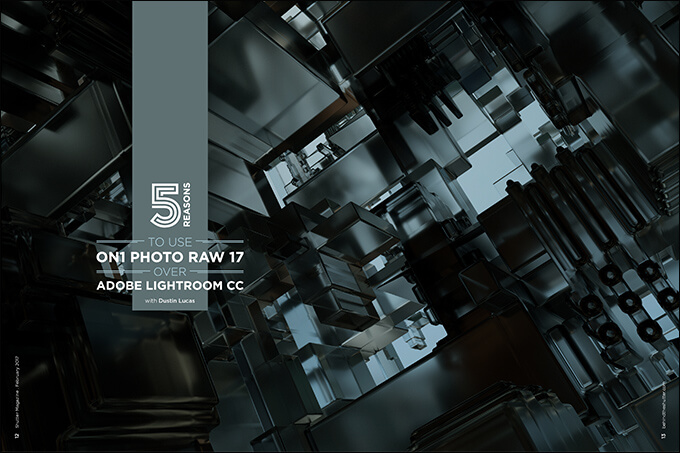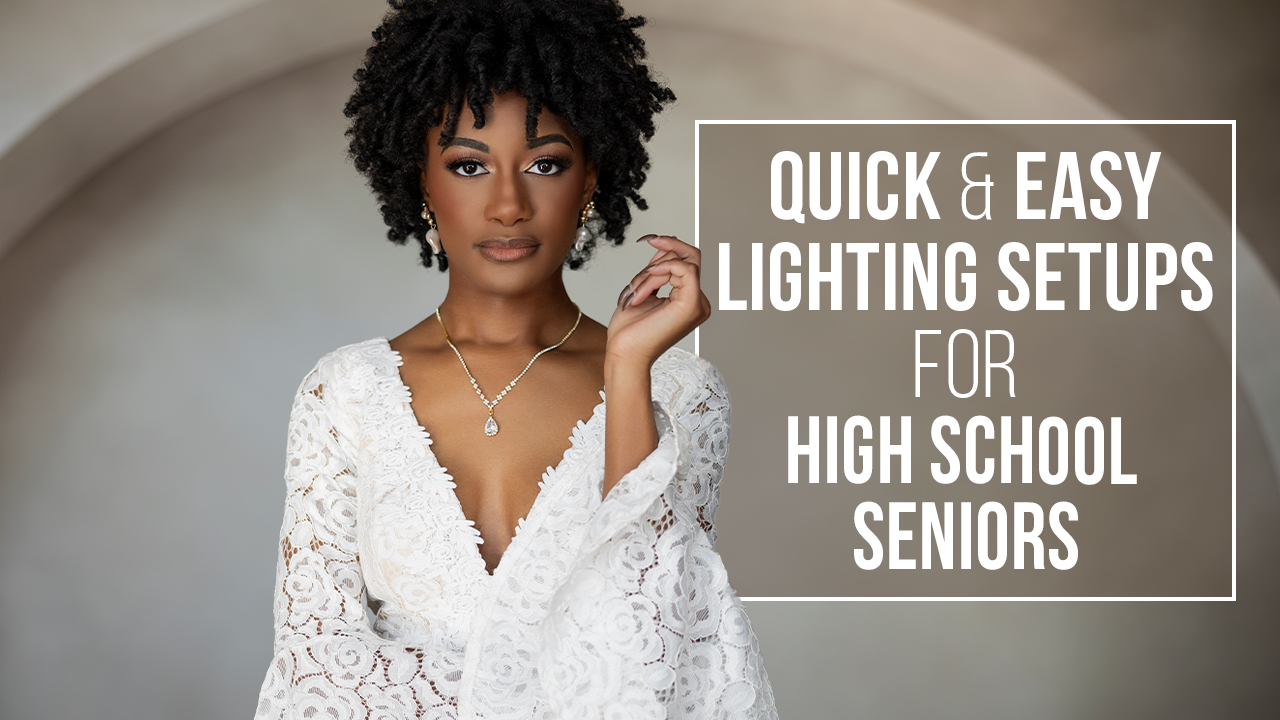5 Reasons to Use On1 Photo RAW 2017 Over Lightroom CC with Dustin Lucas
Want more information on this article? Get access to video content and additional supporting images. Launch the February issue of the magazine by logging in or signing up for a free account by clicking here. Shutter Magazine is the industry’s leading professional photography magazine.
As a long-time Lightroom user, I am always looking for a program to handle my Raw files better. It’s not that I have a bunch of complaints against Lightroom—I just want the best quality for my images. After taking a test drive with On1’s new and improved RAW 2017 software, I am blown away. It’s time for a change.
Working in On1 RAW 2017 is faster from start to finish—no more cataloging or rendering Raw previews. This helps me to get going quickly on selection, but more importantly to start editing my creatives. With the nondestructiveness and syncability between images, I can navigate from adjusting Develop settings to applying stylistic Effects. This has layers for Develop settings, layers for Effects, and an entire editing panel dedicated to editing with Photoshop-like Layers. We can build up our creativity and don’t have to rely on Photoshop for our end-all program. There are new Develop panel adjustment tools that expand the quality of Raw files. The versatility of Masking across all panels is a massive upgrade.
Faster From Start to Finish
Let’s start by opening the program and accessing my images instantly. Wait, don’t I have to import the images and make a catalog? Say goodbye to waiting for and building previews for what seems like days. On1 developed its Browse software to essentially treat your images like actual previews rather than having to wait for the Raws to render. I can access all my images instantaneously.
I can search in the left panel, but I have so many drop-down folders. Instead, let’s hold Command and strike the “B” key. My handy Finder window pops up, and I am ready to search my folder of files. After selecting the folder and clicking Open, we are ready to start working. The first thing I notice about each image I view is that there are 1:1 previews instantly built. This is the same time it takes for Lightroom to make a Standard preview. You’ll notice the difference when zooming at 100% and waiting for Lightroom to load for a few seconds. No more waiting with On1 RAW.
Rating images is virtually the same in Lightroom, except they added purple to the color labels, which you can access by striking “0.” You can unstar-rate an image by striking the “`” key. I use “Lights Out” mode for Lightroom when selecting, but I couldn’t find the equivalent option in On1. I am not too worried about that. Photo Mechanic still ranks as the best for culling. Better yet, these star ratings and color labels will read from the XMPs saved in Photo Mechanic as well.
Nondestructiveness and Syncability
Nondestructive editing is a must when working with your Raw files. There’s nothing more annoying than having to render PSDs just to start your creative edits. This brings up an important point for choosing the right Preference settings right out of the gate. Go to Preference by holding Command and the comma key. I like keyboard shortcuts for everything. Go to the Files tab and, under the Sidecar Options, check the box below. Similar to XMP files from Adobe, these proprietary sidecar files save your metadata outside the program.
This is even more useful for sharing files between computers and seeing the edits immediately. Yes, I said that right, sharing files between computers allows you to instantly share metadata on the fly. No more saving metadata to files and reading metadata when working in a different catalog. This was and is a huge workflow for Lightroom when working on multiple machines and backing up catalogs, saving metadata, importing metadata, etc. Say no to inefficiency and yes to On1 RAW 2017.
Working in a cloud-based system would be the ideal way to do this. In the Browse panel to the left, you can choose to use Dropbox, Google Drive or OneDrive folders. These local folders continually sync to your cloud storage and allow for machine-to-machine syncability. You may be worried that your Internet is too slow and this would not be efficient for you. Well, that is why you are accessing your Raw files from a local folder that syncs changes to your cloud storage app.
So why isn’t it slow? With the option to autosave ON1’s proprietary metadata files we selected earlier, these are the only files that are changing and syncing. That means we aren’t having to save image files with every editing change; it’s completely nondestructive. These total in size form 10 to 100 kilobytes, which is nothing. Try it out for yourself. This is huge for photo teams accessing networked drives and sharing files across the network. All in all, I am very happy with the speed and quick access I have to the images to start editing. Now, on to the other panels listed on the right-hand side: Develop, Effects, Layers and Resize.
Extensive Develop Panel Adjustments
As soon as I start working on my image, I notice the Overall or basic settings are a bit out of order and my image is much sharper. Not to worry: On1 is thinking about how we edit. I wouldn’t mess with white balance before I get my exposure and tone settings dialed in. Just like Lightroom, sharpening is automatically applied. We can get into that setting later.
I do, however, utilize the before-and-after previews when editing. It seems I have only a split-down-the-middle option for now, and I hope this will be updated soon. For now, I can strike the “\” key to toggle my shot out of camera and On1 edit. I am also missing my filmstrip, which allows me to quickly cycle between images; strike the “F” key to bring this back.
Now that I am feeling a bit more familiar with On1 Develop, let’s dive in. Starting with the Tone section, we have the usual suspects from Exposure to Black Point, along with the ability to auto-tone the image. Wait, ON1 dropped the Clarity slider and replaced it with Structure? What’s that? I’ve used this before in Nik Silver Effects Pro 2, and I think it does a much better job with skin tones. This boosts the midtones and works with contrast more locally. I like it better.
Moving down to the Color section, we see similar settings from Temp and Tint, to Saturation and Vibrance. They added a Reduce Vibrance on Skin feature that works quite well. Originally, Vibrance was designed to do this, but it still turns the skin orange and the suits and dress blue. Now you have the ability to remove this without dropping all the orange or blue tones with HSL. This new feature in the Purity section allows you to desaturate your image in the highlights and shadow tones separately. It’s great for fixing these issues.
Clicking the Show More button, we have so many new options that make this program worth having. They added the ability to retouch skin with sliders. Skin Retouching is an intuitive adjustment that allows you to select the skin tone and a range of other tones. It gives you control of blemish removal, skin smoothing, shine and tint evenness. This tool serves my beauty edit workflow well.
ON1’s Sharpening panel had quite an overhaul as well, as adding an opacity slider to allow you to reduce this effect on the entire image. You can choose predetermined settings for output to automate your slider settings. They added different processes to sharpen images, including High Pass, Progressive and UnSharp Mask. (15) There is a new section dedicated to protecting certain tones like shadows, highlights and skin. The program is focused on protecting skin tones—I am too.
A couple of missing features are lens correction and camera profile settings. After researching these settings, it appears that lens correction is auto-applied and can be manually adjusted in the Transform panel. In terms of camera profile, the image untouched looks better than Adobe Standard in Lightroom. I assume On1 is automatically controlling this profile, which looks similar to Adobe’s Camera Neutral.
Layers, Layers, Layers
Jumping into On1 Develop local adjustments, I can edit with brushes and layer my adjustments. To do this, strike the “K” key at any time while in On1 Develop. Yes, you heard me right, I can layer these adjustments. It’s way less clunky than the edit pin system in Lightroom. Your adjustments are pretty straightforward, with some added predetermined settings.
The brush settings are similar to Lightroom, and the Perfect brush has been added as well. This is called Automask in Lightroom. It works pretty similarly in that you can paint over hard edges, and it separates these for you. Hold Command and the “R” key to turn this on and off.
There are a lot of keyboard shortcuts for making your brush work so much faster. To toggle the Paint In and Paint Out brush setting on your mask, strike the “X” key or hold Option while clicking and dragging the cursor over an area. I find the Option + click and drag method to be much faster. Changing the brush size is easy: To increase it, strike the “]” key; to reduce the size, hit “[.” To change the feather, hold Shift and the “[“ “]” keys to increase or decrease. The same goes for brush opacity, except you hold the Option key. Striking the “O” key allows you to view the mask overlay with your image.
Moving into On1 Effects, we can layer filters in the same way as Local adjustments. Using Textures on my creative edits has always forced me to open my exported images into Photoshop. Now I can do this all in a single program without exporting anything. (20) With textures, I have to mask out the skin, so this effect doesn’t make the client look bad. All I have to do is strike “B” and toggle the mode to Paint Out. Another great feature is that I can import my textures, even the ones loaded to Photoshop. This is a must for my creative workflow.
Other useful filters include Color Enhancer, Dynamic Contrast and Skin Retouching, which gives you more control over your images. All of these allow more localized adjustments because they all have paintable masks. Let’s move into the world of masking.
The Versatility of Masking
As if On1 RAW doesn’t already give your images more flexibility in color correction and creative processing, they have brought an effective masking solution to each Effects filter, along with opacity sliders. Much like Local Adjustments, you can stack or layer these effects and paint the effects in or out as you see fit.
These masks are adjustable after you close the program, and you can always reset to start over. I find that inverting the mask (Command + “I”) and painting in the effect is quicker when working with smaller areas. You can also quickly copy and paste the mask created to other filters. This is a huge advantage over Lightroom.
The Results
On1 is giving Lightroom and other Raw processors a run for their money. This program is starting to look like a one-stop shop for photographers. From instantly browsing images in your cloud storage to editing beyond basic settings, with On1 Develop, you can do quite a bit in the first five minutes after opening your image. You can add creative effects with masking capabilities, sync them to other images and save metadata between computers.
The only question remains: Are you going to try out this software for yourself? Grab it now while it’s on sale.
Want more information on this article? Get access to video content and additional supporting images. Launch the February issue of the magazine by logging in or signing up for a free account by clicking here. Shutter Magazine is the industry’s leading professional photography magazine.





